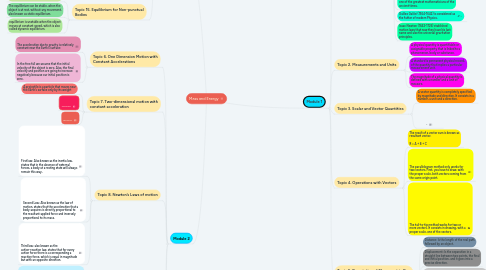
1. Module 2
1.1. Topic 6. One Dimension Motion with Constant Accelerations
1.1.1. The acceleration due to gravity is relatively constant near the Earth’s surface:
1.1.2. In the free fall we assume that the initial velocity of the object is zero. Also, the final velocity and position are going to increase negatively because our initial position is zero.
1.2. Topic 7. Two-dimensional motion with constant acceleration
1.2.1. A projectile is a particle that moves near the Earth’s surface only by its weight
1.2.2. POSITION
1.2.3. VELOCITY
1.3. Topic 8. Newton’s Laws of motion
1.3.1. First law: Also known as the inertia law, states that in the absence of external forces, a body at a resting state will always remain this way,
1.3.2. Second Law: Also known as the law of motion, states that the acceleration that a body acquires is directly proportional to the resultant applied force and inversely proportional to its mass.
1.3.3. Third law: also known as the action-reaction law, states that for every action force there is a corresponding a reaction force, which is equal in magnitude but with an opposite direction.
1.4. Topic 9. Graphical, Qualitative and Quantitative Description of Force
1.4.1. Normal: Is a contact force due to contact between an object with a plane or a surface and this force has a direction that is perpendicular to the contact surface.
1.4.2. Tension in a rope: A force manifested in every point of a rope due to the application of two equal forces on each end of the rope.
1.4.3. Free Body Diagram
1.4.4. Friction When two surfaces are in contact, the friction forces oppose relative or impending motion.
1.5. Topic 10. Applications of Newton's Laws
1.5.1. E Fy=ma
1.5.2. s
2. Module 3
2.1. Topic 11. Mechanical Work and Kinetic Energy
2.1.1. Work is a scalar quantity equal to the product of the x-displacement and the component of the force in the same direction of the motion
2.1.2. Kinetic energy is the capability of doing work with motion (mass and velocity).
2.2. Topic 12. Potential Energy and the Principle of Conservation of Mechanical Energy
2.2.1. Potential energy is the capability of doing work given a position or condition
2.2.2. Energy conservation principle stablishes that energy cannot be created or destroyed, only transformed.
2.3. Topic 13. Kinematics of Rotational Motion
2.3.1. Period: is the time that it takes to do a complete turn, also called a revolution.
2.3.2. Frequency: Is the number of turns over time.
2.4. Topic 14. Rotational Motion Dynamics
2.4.1. The torque is a vector quantity that has direction and magnitude. As a convention, counterclockwise torque is positive and clockwise torque is negative.
2.4.2. Rotational Inertia
2.5. Topic 15. Equilibrium for Non-punctual Bodies
2.5.1. which can be of two types: translational and rotational.
2.5.2. The equilibrium can be stable, when the object is at rest, without any movement, also known as static equilibrium.
2.5.3. equilibrium is unstable when the object moves at constant speed, which is also called dynamic equilibrium.
3. Module 1
3.1. Topic 1. History of Physics
3.1.1. Physics is the science that researches the fundamental concepts of matter, energy and space, and the relationships among them.
3.1.2. Aristotle (384–322 BC) tried to stablish general principles that ruled the behavior of natural bodies
3.1.3. e
3.1.4. Archimedes (287-212 BC) is considered one of the greatest mathematicians of the ancient times.
3.1.5. Galileo Galilei (1564-1642) is considered as the father of modern Physics.
3.1.6. Isaac Newton (1642-1726) stablished motion laws that now they have his last name and also the universal gravitation principles.
3.2. Topic 2. Measurements and Units
3.2.1. A physical quantity is quantifiable or assignable property that is linked to a phenomenon, body or substance.
3.2.2. A standard is permanent physical record, of the quantity that implies a particular measurement unit.
3.2.3. The magnitude of a physical quantity is defined with a number and a unit of measure.
3.3. Topic 3. Scalar and Vector Quantities
3.3.1. A vector quantity is completely specified by magnitude and direction. It consists in a number, a unit and a direction.
3.3.2. f
3.4. Topic 4. Operations with Vectors
3.4.1. The result of a vector sum is known as resultant vector. R = A + B + C
3.4.2. The parallelogram method only works for two vectors. First, you have to draw, with the proper scale, both vectors coming from the same origin point.
3.4.3. The tail-to-tip method works for two or more vectors. It consists in drawing, with a proper scale, one of the vectors.
3.5. Topic 5. Description of Movement in One Dimensions
3.5.1. Distance: Is the length of the real path followed by an object.
3.5.2. Displacement: Is the separation in a straight line between two points, the final and initial position, and it goes into a precise direction.
3.5.3. Speed: Is the travelled distance per unit of time.
3.5.4. Velocity: Is the displacement per unit of time.
